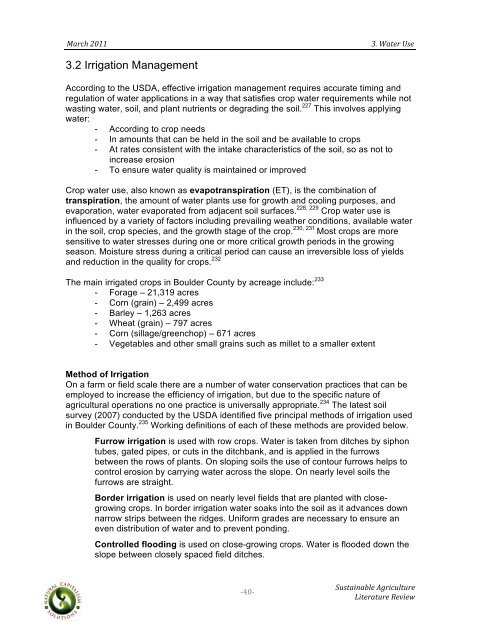Sustainable Agriculture Literature Review - Boulder County
Sustainable Agriculture Literature Review - Boulder County
Sustainable Agriculture Literature Review - Boulder County
Create successful ePaper yourself
Turn your PDF publications into a flip-book with our unique Google optimized e-Paper software.
! !!<br />
"#$%&!'())!! !!!!!!!!!!!!!!!!!!!!!!!!!!!!!!!!!!!!!!!!!!!!!!!!!!!!!!!!!!!!!!!!!!!!!!!!!?=!@#-2$!A,2!<br />
3.2 Irrigation Management<br />
According to the USDA, effective irrigation management requires accurate timing and<br />
regulation of water applications in a way that satisfies crop water requirements while not<br />
wasting water, soil, and plant nutrients or degrading the soil. 227 This involves applying<br />
water:<br />
- According to crop needs<br />
- In amounts that can be held in the soil and be available to crops<br />
- At rates consistent with the intake characteristics of the soil, so as not to<br />
increase erosion<br />
- To ensure water quality is maintained or improved<br />
Crop water use, also known as evapotranspiration (ET), is the combination of<br />
transpiration, the amount of water plants use for growth and cooling purposes, and<br />
evaporation, water evaporated from adjacent soil surfaces. 228, 229 Crop water use is<br />
influenced by a variety of factors including prevailing weather conditions, available water<br />
in the soil, crop species, and the growth stage of the crop. 230, 231 Most crops are more<br />
sensitive to water stresses during one or more critical growth periods in the growing<br />
season. Moisture stress during a critical period can cause an irreversible loss of yields<br />
and reduction in the quality for crops. 232<br />
The main irrigated crops in <strong>Boulder</strong> <strong>County</strong> by acreage include: 233<br />
- Forage – 21,319 acres<br />
- Corn (grain) – 2,499 acres<br />
- Barley – 1,263 acres<br />
- Wheat (grain) – 797 acres<br />
- Corn (sillage/greenchop) – 671 acres<br />
- Vegetables and other small grains such as millet to a smaller extent<br />
Method of Irrigation<br />
On a farm or field scale there are a number of water conservation practices that can be<br />
employed to increase the efficiency of irrigation, but due to the specific nature of<br />
agricultural operations no one practice is universally appropriate. 234 The latest soil<br />
survey (2007) conducted by the USDA identified five principal methods of irrigation used<br />
in <strong>Boulder</strong> <strong>County</strong>. 235 Working definitions of each of these methods are provided below.<br />
!<br />
Furrow irrigation is used with row crops. Water is taken from ditches by siphon<br />
tubes, gated pipes, or cuts in the ditchbank, and is applied in the furrows<br />
between the rows of plants. On sloping soils the use of contour furrows helps to<br />
control erosion by carrying water across the slope. On nearly level soils the<br />
furrows are straight.<br />
Border irrigation is used on nearly level fields that are planted with closegrowing<br />
crops. In border irrigation water soaks into the soil as it advances down<br />
narrow strips between the ridges. Uniform grades are necessary to ensure an<br />
even distribution of water and to prevent ponding.<br />
Controlled flooding is used on close-growing crops. Water is flooded down the<br />
slope between closely spaced field ditches.<br />
"%,"<br />
!*+,-#./#012!34$.%+1-+$2!<br />
5.-2$#-+$2!627.28!
















